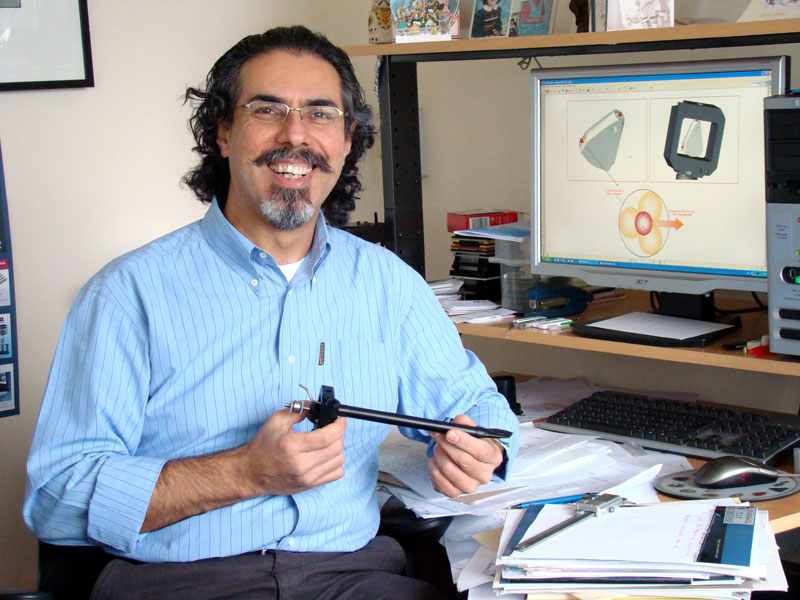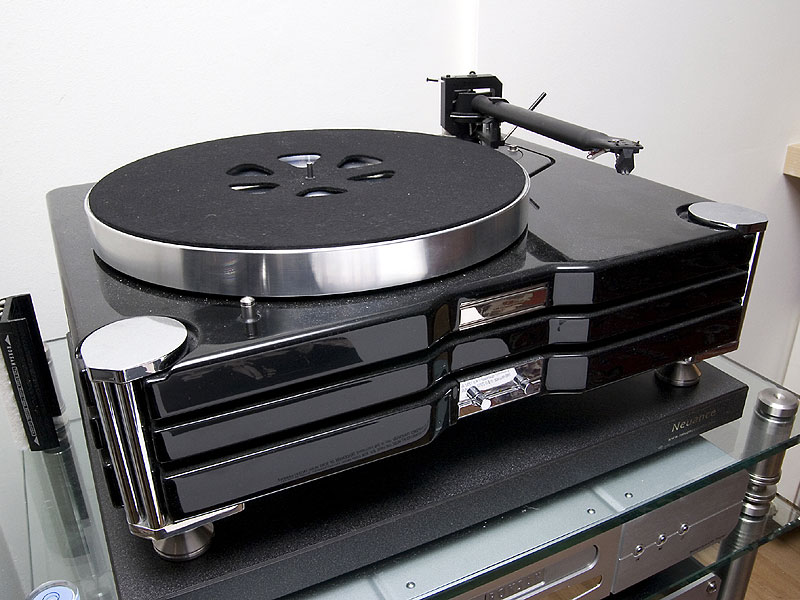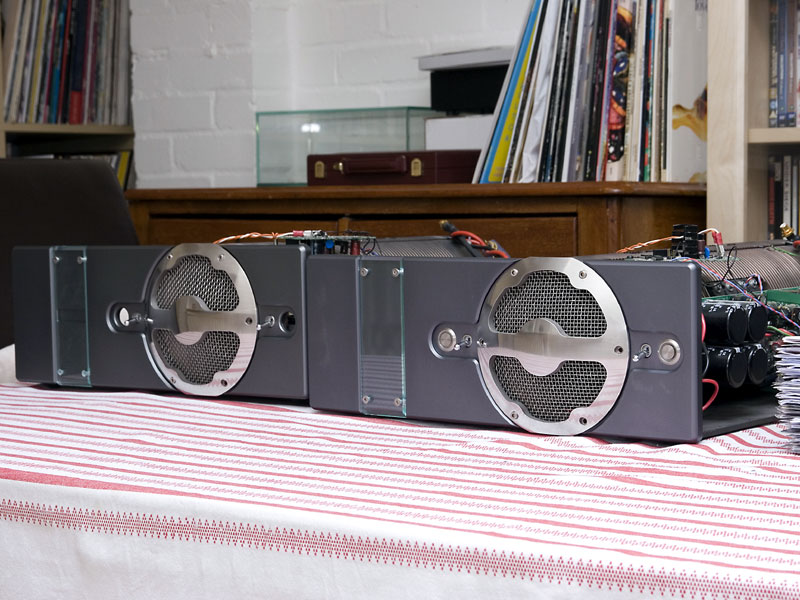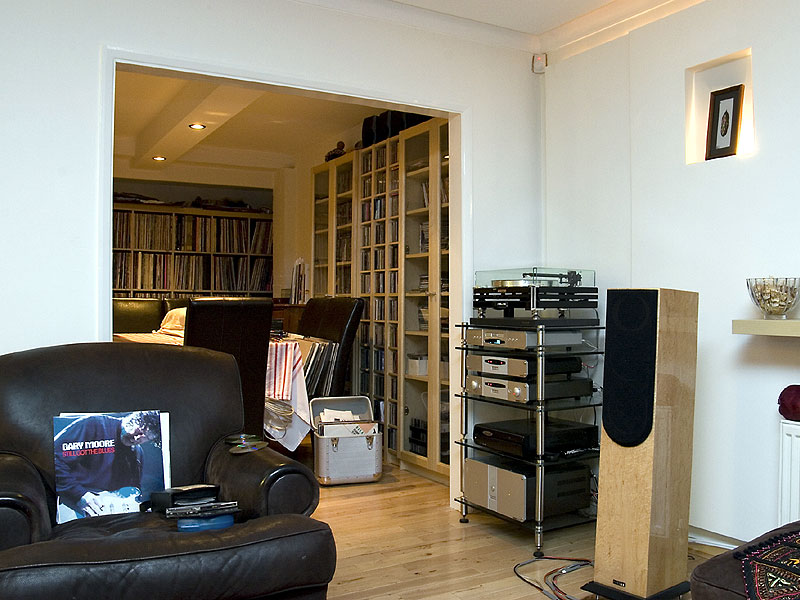Roksan and TMsystems: An Eclectic Audio Vision
ver since he founded Roksan in 1985, Touraj Moghaddam has been an on-the-ball and upbeat presence on the UK audio scene. His first hi-fi product, the Xerxes turntable, was full of new ideas that are still found in the Roksan turntables today, including the TMS3 (below, $18,250), which is the ultimate incarnation of those ideas.
The Xerxes was built on the Linn philosophy that timing is the most critical aspect of music reproduction, but it took a completely different approach to achieving its goal. The motor, for instance, runs at a much lower torque than that of most other turntables, and any pressure on it will cause it to stall. Therefore, rather than being fixed to the plinth, it is mounted on a bearing so it can rotate. The suspension, such as it is, consists of rubber isolators and a cutout in the top plate that allow the tonearm and platter a very limited range of movement in the same plane. Then you have things like a removable spindle, so that the vinyl is not touching anything apart from a felt mat. The Xerses makes an extremely compelling sound, and it knocked the LP12 into a cocked hat when it came to Linn’s "pace, rhythm and timing" mantra.
The TMS3 turntable has considerably better isolation and a stunning finish, so naturally it forms the center of Touraj’s home system, alongside some more modest components. When I visited, he had a Caspian M2 CD player ($2915), a Platinum PR15B preamp ($7535) and an ST1038 stereo power amp ($9945) from the current Roksan range. But on the dining table I discovered something rather more interesting in the form of prototype mono power amps (shown below). Touraj says that the amps' retro styling is not likely to be reflected in the finished product, which is a great pity. They look stunning, but I can see that they might be a bit of a commercial challenge, unless, of course, Touraj builds a CD player and preamp in the same style.
You can just about see from the picture that the circular grille on the front leads into a substantial tubular heatsink that runs front to back through the amplifier. Touraj’s thinking is that there is often something above and below an amplifier but rarely anything in front of or behind it, so it makes sense to let the heat escape that way. Each amp delivers 200 watts into 8 ohms and doubles its output into 4 ohms. The buttons you see are separate standby switches for the front and rear sections of the amp, so you can keep the input stage warm without burning up power with the output stage. Sadly, one of the amps had suffered a tweeter-killing failure shortly before my visit, so I wasn't able to hear them. And the tweeter it took out was also part of a new product, a revival of sorts: a loudspeaker that continues the approach found in Touraj’s first speaker, the Darius. Those with a long memory will recall this speaker, a design whose distinction was that its tweeter was suspended on springs in an attempt to isolate it from cabinet resonance. Another distinguishing feature was a stand that formed a frame all around this large stand-mounted speaker and which held it by spikes top and bottom. Apparently there is still a lot of interest in that 1980s design, so the new speaker will incorporate ideas like the suspended tweeter, albeit in a rather less crude fashion. I recall being very impressed by the original Darius when I heard it in 1987 on the end of a Xerxes-sourced system with Bryston amplification (or Omtec -- I'm not sure which all these years later). Eric Clapton’s solo on the Roger Waters album The Pros and Cons of Hitchhiking provided one of the most convincing reproductions of electric guitar I’ve encountered. Touraj’s current system maintains that quality with an uncanny level of vitality and temporal coherence. The track "Fit" from Cornelius’s Sensuous LP [Everloving 016] is a metronomic workout that usually sounds very percussive but rarely displays the scale and dynamics that Touraj's system managed to extract. The sound leaped out of the speakers and took up the entire wall behind in a precise and three-dimensional fashion that was full of life.
Touraj puts much of this result down to the cables that he has also been working on and which have been brought to market as the TMsystems PulseB ($620/meter pair), an interconnect that’s soon to be joined by a matching speaker cable. TMsystems is Touraj's R&D company. He fine-tuned and voiced some of Roksan's latest products, including the M2 CD player, through his TMsystems work, exploring the highest of the high end. The aim with the TMsystems cables is to make the results of putting different products in different systems and rooms a lot more predictable. On my visit, I took along a pair of Townshend DCT interconnects that I generally use for reviewing and was bowled over by how much more alive, open and tight the PulseBs sounded. They did this without adding glare or grain, and neither did they reduce extension in the bass, which had less overhang and was distinctly faster. Transients were probably what the interconnects did best, and this made for a thrilling and revealing result that reveled in spatial as well as timing cues. I managed to borrow a run of balanced PulseB interconnects and tried them at home. The results through a completely different, actively powered system delivered the same coherence and increased engagement. Each musician was easy to follow and seemed to be playing more precisely. The overall result was an improved sense of timing. Touraj started out making PulseB interconnects by hand, but that has proved too time-consuming to be practical and is now reserved for tonearm rewiring. The PulseB is manufactured to keep costs down and is available as a tonearm cable ($765/meter length), balanced or single ended interconnects and even as a guitar lead. There is now also a PulseX speaker cable (shown below, $1395/eight-foot pair) based on the same principles as the interconnect -- principles that are explained in some detail at www.tmsaudio.co.uk. What I heard was the difference between a handmade prototype of the PulseX and the finished article, the latter delivering coherence and vivacity along with added focus and seemingly increased separation between channels.
I don’t go in for cables in a big
way -- they usually don't do anything that a tone control can’t -- but Touraj’s
approach is clearly unique. If the two systems I’ve heard these cables in are any
indication, the PulseB and PulseX live up to Touraj's professed goal of working no matter
the ancillary equipment. |





